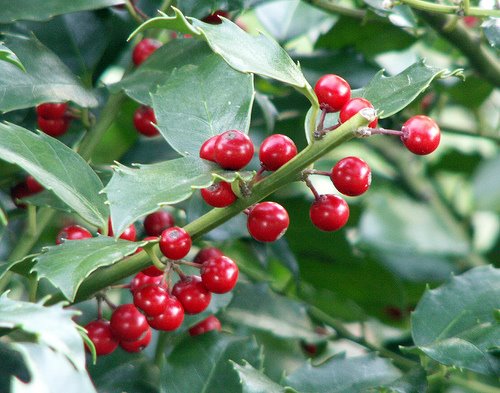In the dark days of winter, gardens big and small sleep silently under a chilly blanket. As we come to the winter solstice 21st December, the shortest day in deepest winter, the old oak woodlands and hills that roll down to the villages of North Hampshire here in the UK are sparkling with heavy frost.
Glistening among the woodland trees and frozen hedgerows is a tree of red berries to cheer us up on these winter days, The European Holly (ilex aquifolium).
Holly is an Evergreen broadleaved tree of which there are over 400 different species distributed worldwide, most of them with the characteristic spiny leaves. Holly is dioecious, which means that individual trees are either male or female, so it is important when planting a tree that you either plant both genders, or you make sure there is a male/female in the neighbourhood. Holly trees will tolerate most well drained soil types and are happy in both full sun and partial shade. As with all trees and shrubs soak the root ball prior to planting. Dig a hole at least twice the size of the pot or bare root and add in plenty of compost and a handful of fish blood and bone meal. Keep well watered in its first year especially during the summer months.
The tree will not start producing flowers until it reaches approximately 20 years of maturity. They are white in colour, and appear in May/ June. Pollination between species is mostly undertaken by bees.
It is the female tree who's flowers once pollinated go on to produce berries which start green in colour and go on in mid winter to ripen to the bright red that we all know. Never eat them of course leave that for the birds. Toxic holly berries if ingested can cause at the very least a nasty stomach upset
General discussion and your views are welcome please say hello. I regret however because of my busy schedule, I am unable to answer many questions. Sneaky advertising will be deleted sorry. Thanks so much for visiting my blog today.





4 comments:
Never seen one myself. Looks so rich in color and maybe taste.
Hi Flower, thanks for your comment.
Yes they are very rich in colour, but holly and Ivy berries are poisonous except to birds.
Best wishes, Simon
yep, taste for the birds, I mean. Sorry bout that. I tend to mumble my words and not mention stuff ;p Thanks for the heads up anyways.
:-)Thankyou
Post a Comment